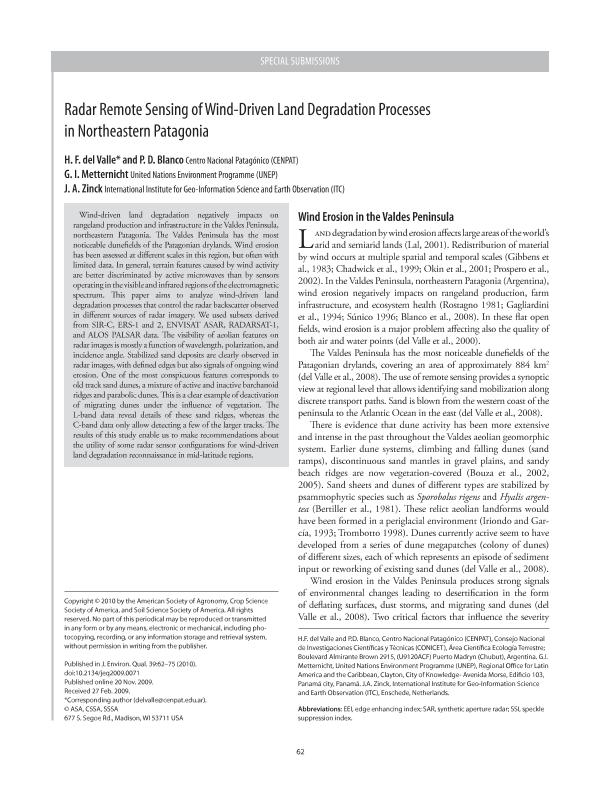Mostrar el registro sencillo del ítem
dc.contributor.author
del Valle, Hector Francisco

dc.contributor.author
Blanco, Paula Daniela

dc.contributor.author
Metternicht, Graciela

dc.contributor.author
Zinck, J. A.
dc.date.available
2018-10-19T17:47:38Z
dc.date.issued
2010-01
dc.identifier.citation
del Valle, Hector Francisco; Blanco, Paula Daniela; Metternicht, Graciela; Zinck, J. A.; Radar remote sensing of wind-driven land degradation processes in northeastern Patagonia; American Society of Agronomy; Journal of Environmental Quality; 39; 1; 1-2010; 62-75
dc.identifier.issn
0047-2425
dc.identifier.uri
http://hdl.handle.net/11336/62795
dc.description.abstract
Wind-driven land degradation negatively impacts on rangeland production and infrastructure in the Valdes Peninsula, northeastern Patagonia. Th e Valdes Peninsula has the most noticeable dunefields of the Patagonian drylands. Wind erosion has been assessed at different scales in this region, but often with limited data. In general, terrain features caused by wind activity are better discriminated by active microwaves than by sensors operating in the visible and infrared regions of the electromagnetic spectrum. Th is paper aims to analyze wind-driven land degradation processes that control the radar backscatter observed in different sources of radar imagery. We used subsets derived from SIR-C, ERS-1 and 2, ENVISAT ASAR, RADARSAT-1, and ALOS PALSAR data. Th e visibility of aeolian features on radar images is mostly a function of wavelength, polarization, and incidence angle. Stabilized sand deposits are clearly observed in radar images, with defined edges but also signals of ongoing wind erosion. One of the most conspicuous features corresponds to old track sand dunes, a mixture of active and inactive barchanoid ridges and parabolic dunes. Th is is a clear example of deactivation of migrating dunes under the influence of vegetation. Th e L-band data reveal details of these sand ridges, whereas the C-band data only allow detecting a few of the larger tracks. Th e results of this study enable us to make recommendations about the utility of some radar sensor configurations for wind-driven land degradation reconnaissance in mid-latitude regions.
dc.format
application/pdf
dc.language.iso
eng
dc.publisher
American Society of Agronomy

dc.rights
info:eu-repo/semantics/openAccess
dc.rights.uri
https://creativecommons.org/licenses/by-nc-sa/2.5/ar/
dc.subject
C-Band
dc.subject
L-Band
dc.subject
Radar Sensor Configuration
dc.subject
Mid-Latitude Regions
dc.subject.classification
Meteorología y Ciencias Atmosféricas

dc.subject.classification
Ciencias de la Tierra y relacionadas con el Medio Ambiente

dc.subject.classification
CIENCIAS NATURALES Y EXACTAS

dc.title
Radar remote sensing of wind-driven land degradation processes in northeastern Patagonia
dc.type
info:eu-repo/semantics/article
dc.type
info:ar-repo/semantics/artículo
dc.type
info:eu-repo/semantics/publishedVersion
dc.date.updated
2018-10-12T18:04:38Z
dc.identifier.eissn
1537-2537
dc.journal.volume
39
dc.journal.number
1
dc.journal.pagination
62-75
dc.journal.pais
Estados Unidos

dc.description.fil
Fil: del Valle, Hector Francisco. Consejo Nacional de Investigaciones Científicas y Técnicas. Centro Nacional Patagónico; Argentina
dc.description.fil
Fil: Blanco, Paula Daniela. Consejo Nacional de Investigaciones Científicas y Técnicas. Centro Nacional Patagónico; Argentina
dc.description.fil
Fil: Metternicht, Graciela. Regional Office for Latin America and the Caribbean; Panamá
dc.description.fil
Fil: Zinck, J. A.. International Institute for Geo-Information Science and Earth Observation; Países Bajos
dc.journal.title
Journal of Environmental Quality

dc.relation.alternativeid
info:eu-repo/semantics/altIdentifier/doi/http://dx.doi.org/10.2134/jeq2009.0071
dc.relation.alternativeid
info:eu-repo/semantics/altIdentifier/url/https://dl.sciencesocieties.org/publications/jeq/abstracts/39/1/62
Archivos asociados
